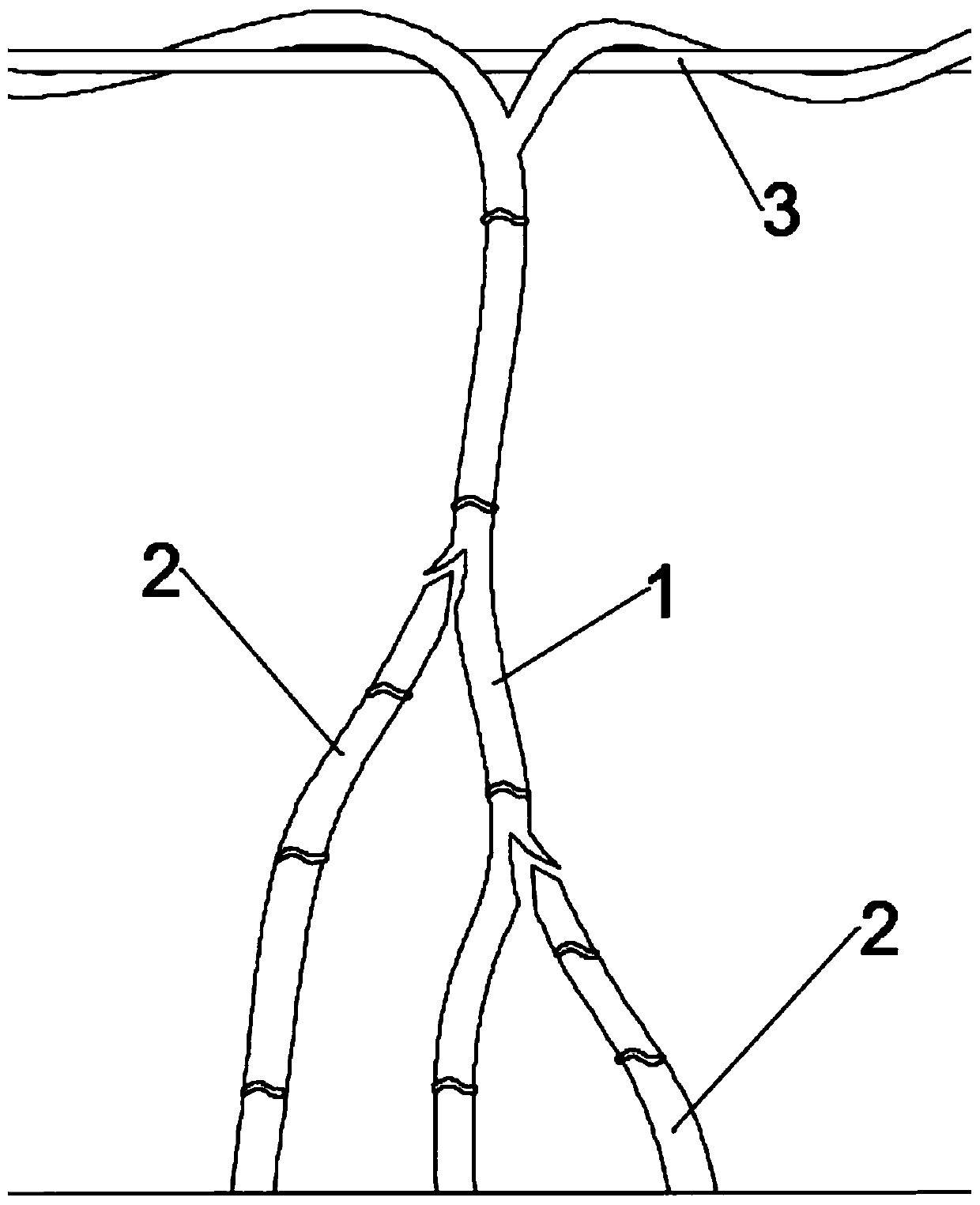A secondary docking cultivation method for preventing and controlling passion fruit stem rot
A technology of stem base rot and cultivation method, which is applied in the field of secondary abutment cultivation for preventing and controlling stem base rot of passion fruit, can solve problems such as hindering the development of passion fruit industry, withering and dying of leaves and branches of plants, etc. Reduces devastating impact, promotes plant growth, increases yield
- Summary
- Abstract
- Description
- Claims
- Application Information
AI Technical Summary
Problems solved by technology
Method used
Image
Examples
Embodiment 1
[0030] A secondary docking cultivation method for preventing and controlling passion fruit stalk rot, comprising the following steps,
[0031] (1) selection of anti-stem rot disease-free grafted seedlings: seedling rootstock is the yellow passion fruit variety seedling of anti-stem rot disease, and scion selects the branch of the excellent variety of passion fruit without virus after detection, and grafts; The grafted seedling that obtains afterward is cultivated to 30cm high;
[0032] (2) selection of docking varieties: select the seedlings bred by the yellow passion fruit variety seeds of resistance to stem base rot as docking varieties; the grafted seedlings obtained after grafting are cultivated to a height of 30 cm.
[0033] (3) Soil preparation and tree tray arrangement: deep plow and rake the land, raise the high border and dig out the planting holes, fertilize the planting holes, organize into tree trays higher than the original surface, the tree trays are 20cm higher ...
Embodiment 2
[0041] A secondary docking cultivation method for preventing and controlling passion fruit stalk rot, comprising the following steps,
[0042] (1) selection of anti-stem rot disease-free grafted seedlings: seedling rootstock is the yellow passion fruit variety seedling of anti-stem rot disease, and scion selects the branch of the excellent variety of passion fruit without virus after detection, and grafts; The grafted seedling obtained afterwards is cultivated to a height of 50 cm;
[0043] (2) selection of docking varieties: select the seedlings bred by the yellow passion fruit variety seeds of resistance to stem base rot as docking varieties; the grafted seedlings obtained after grafting are cultivated to a height of 50 cm.
[0044] (3) Soil preparation and tree tray arrangement: deep plow and rake the land, raise high borders to excavate planting holes, fertilize the planting holes, organize into tree trays higher than the original surface, the tree trays are 30cm higher th...
Embodiment 3
[0052] A secondary docking cultivation method for preventing and controlling passion fruit stalk rot, comprising the following steps,
[0053] (1) selection of anti-stem rot disease-free grafted seedlings: seedling rootstock is the yellow passion fruit variety seedling of anti-stem rot disease, and scion selects the branch of the excellent variety of passion fruit without virus after detection, and grafts; The grafted seedling obtained afterwards is cultivated to a height of 35 cm;
[0054] (2) selection of docking varieties: select the seedlings bred by the yellow passion fruit variety seeds of resistance to stalk base rot as docking varieties; the grafted seedlings obtained after grafting are cultivated to a height of 35 cm.
[0055] (3) Soil preparation and tree tray arrangement: deep plow and rake the land, raise high borders to dig out planting holes, fertilize the planting holes, organize into tree trays higher than the original surface, the tree trays are 25cm higher th...
PUM
 Login to View More
Login to View More Abstract
Description
Claims
Application Information
 Login to View More
Login to View More - R&D
- Intellectual Property
- Life Sciences
- Materials
- Tech Scout
- Unparalleled Data Quality
- Higher Quality Content
- 60% Fewer Hallucinations
Browse by: Latest US Patents, China's latest patents, Technical Efficacy Thesaurus, Application Domain, Technology Topic, Popular Technical Reports.
© 2025 PatSnap. All rights reserved.Legal|Privacy policy|Modern Slavery Act Transparency Statement|Sitemap|About US| Contact US: help@patsnap.com

